|
 The
mystery surrounding Anastasia's fate after the Russian Revolution
in 1918 is one of the biggest mysteries of the 20th Century.
Many stories about her and recently the 20th Century Fox movie,
entitled Anastasia, have brought the mystery alive again into the
21st Century. The
mystery surrounding Anastasia's fate after the Russian Revolution
in 1918 is one of the biggest mysteries of the 20th Century.
Many stories about her and recently the 20th Century Fox movie,
entitled Anastasia, have brought the mystery alive again into the
21st Century.
After she was gone a number of people went around claiming
to be her. A Polish girl named Franziska Schanzkowska (also known
as Anna Anderson) - who, some say, couldn't even speak Russian and
didn't look like Anastasia, turned up in Berlin claiming to her.
There is even a movie about this woman who had invented a crazy
story about how Anastasia had escaped from Yekaterinburg.
The Anastasia case is one of the most complicated of this
century. It is tied up in family intrigue, royal politics, state
secrets, and disputed bank accounts.
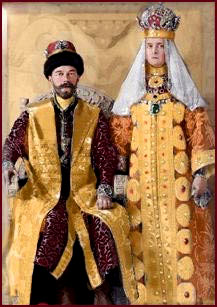 There
were four girls, born right after one another in succession to the
Imperial couple of Nicholas II and Alexandra.
Anastasia, Grand Duches of Russia, the youngest of four children,
was born in 1901 at the Farm Palace in Peterhof. There
were four girls, born right after one another in succession to the
Imperial couple of Nicholas II and Alexandra.
Anastasia, Grand Duches of Russia, the youngest of four children,
was born in 1901 at the Farm Palace in Peterhof.
Anastasia had blue eyes, fine light-brown hair (sometimes
described as reddish blonde) and a thin, delicate nose like her
mother's. People close to the family though she could have become
a real beauty when she grew up.
Anastasia was the youngest, most intelligent and most michievous
of the tsar's daughters. She was an excellent mimic and enjoyed
pranks and practical jokes. Anastasia had a gentle side also. It
was she who would spend hours cheering up her younger hemophiliac
brother and heir to the Russian
throne, Alexei, when he was ill.
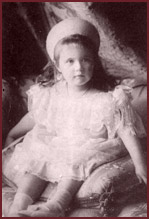 Beneath
the surface of her royal life full of wealth, prominence, and opulence,
you could find a typical preadolescent who misses her father
when absent. Beneath
the surface of her royal life full of wealth, prominence, and opulence,
you could find a typical preadolescent who misses her father
when absent.
Anastasia and her sisters were well liked by all who met
them. They preferred not to be called by their formal titles and
became embarrassed when they were used.
All the Grand Duchesses had been raised in a strict religious
spirit and were taught to treat people with consideration without
any show of superiority, without haughtiness. The Emperor was always
saying: “The more important the man,
the more he should help everyone, and never remind others of his
high position. My children should be like that, too.”
Adhering to this principle in life himself, he raised them to be
kind, gracious and considerate towards everybody. The Empress instilled
in them that faith, that strength of spirit and humility, which
helped them to endure bravely the hardships of banishment and go
through martyrdom. The children literally idolized their parents.
The girls were very close, as was the entire family. They
had limited contact with children their own age, and were, therefore,
most immature for their ages. Anastasia never had a boyfriend. She
was killed at the age of 17.

|
Extracts from the letters of Anastasia
to her father.
Jan.30,1915, p.58
"...I taught Ortino (Tatiana's
French Bulldog) to sit up and beg and today I've taught
her to give her paw and now she can do it. She is so sweet..."
Apr. 7, 1915, p.64
"...We have just finished
dinner. Mother is lying and sisters are sitting nearby.
Tatyana is out, of course, as usual. Shvybzik and Ortino
are lying in Mother's bed and sleeping. They are such darlings..."
June 24, 1916, p.146
"...Maria and I have just
been lying on the grass in front of the balcony... Yesterday
the four of us made a fire and jumped over it. It was wonderful..."
Feb.25,1917, p.188
"...I am sitting in a semi-dark
room now with Olga and Tatiana (they are ill with measles)...
We have breakfast upstairs in our classroom. Only Mother,
Maria and me. Very nice..."
|

|
Like her sisters, Anastasia spoke Russian, French, and
English fluently, but because of their isolation from the outside
world, the girls' Russian was somewhat childish. They usually spoke
English with mother, who was the granddaughter of the late English
Queen Victoria, and Russian with father.
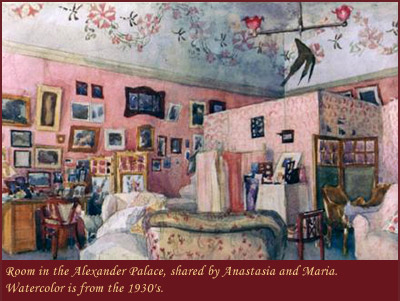
Although her father ruled 1/6th
the globe and was one of the wealthiest men of his day, Anastasia
and her sisters never had their own room.
 The
two eldest, Olga and Tatiana shared one bedroom and the two youngest,
Maria and Anastasia shared the one next door. They lived in one
side of the Alexander Palace,
which isn't so big as palaces go in Russia, there are ONLY around
200 rooms! The
two eldest, Olga and Tatiana shared one bedroom and the two youngest,
Maria and Anastasia shared the one next door. They lived in one
side of the Alexander Palace,
which isn't so big as palaces go in Russia, there are ONLY around
200 rooms!
The girls' quarters were separate from their parents', who lived
downstairs on the main floor and girls lived upstairs with tutors,
nurses, doctors and ladies-in-waiting. There were also classrooms,
music rooms, playrooms, private dining and sitting rooms, as well
as a private little movie theater for Alexei.
The girls were raised relatively simply, bathing in cold
water, sleeping on hard camp beds. The beds went with them everywhere;
even to Germany when the girls visited their Uncle Ernst. They
slept in these same beds until the night they died.

|
|
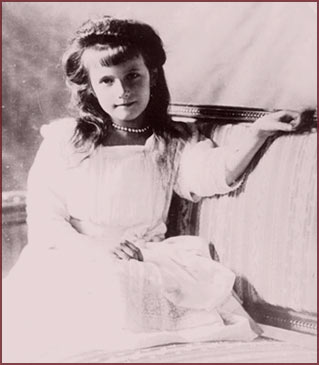
|

|
|
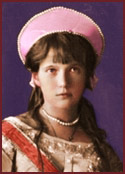 At
the time of the abdication Anastasia and her siblings were
suffering from measles. While they were confined to their
beds the palace was taken over by soldiers. The imperial family
were now prisoners. When the children recovered they went
outside each day with their parents to walk in the park, where
they were harassed and jeered. At
the time of the abdication Anastasia and her siblings were
suffering from measles. While they were confined to their
beds the palace was taken over by soldiers. The imperial family
were now prisoners. When the children recovered they went
outside each day with their parents to walk in the park, where
they were harassed and jeered.
The imperial family had little peace during their
months of captivity. Once, while sewing, Anastasia leaned
repeatedly over a table. As she did so she moved back in forth
in front of two colored lamps. Soldiers outside the window
saw the lights flicker and thought she was sending signals
to some outside accomplice. They burst in and searched the
room, but of course found nothing.
Eventually the imperial family was moved to Siberia.
Their guards were rude and threatening. Anastasia and her
sisters were not permitted to lock their bedroom door at night.
Guards even followed the girls into the bathroom.
|
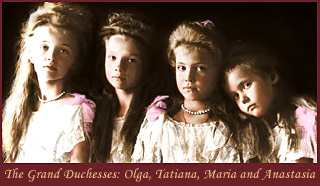
No royal princesses could have been closer than the daughters
of Nickolas and Alexandra.
|
|
The imperial family lived at Ipatiev House in Ekaterinburg
for 78 days. At first the Grand Duchesses were forced to sleep
on the floor. Everyone ate unpalatable food from the public
communist kitchen, and sat at the same table for meals. Most
of the time the guards were drunk, wore their hats, smoked,
spat and swore. They drew indecent pictures on the walls to
taunt the Empress and the girls and stole things from the
Emperor. But gradually even they were impressed by the way
the Imperial Family endured their misery.
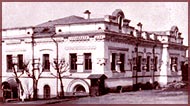 Their
last day was July 16, 1918. Late that night, the family was
awakened and told to get dressed. Their
last day was July 16, 1918. Late that night, the family was
awakened and told to get dressed.
After midnight they were taken to the cellar where, believing
they were to be photographed, they stood in two rows.
Anastasia, carrying her dog Jemmy, stood with her sisters,
their doctor, and three servants.
Suddenly armed men burst into the room and began firing.
Eleven Bolshevik soldiers enter, raise their pistols and
fire. The Tsar and his
wife die quickly. Their teenage daughters, Anastasia and
her sisters, do not. God mercifully spared the parents the
agony of seeing their young ones shot and clubbed to death
with rifle butts when the bullets failed. Sewn inside their
clothes are diamonds, sapphires and other jewels. Meant to
be bartered for freedom, the carefully hidden stones now act
as bullet-proof vests, deflecting the fire, but to the soldiers
it appeared miraculous. Astounded and scared, they kept firing.
Tsarevich Alexei was on
the floor, groaning but alive, so one soldier shot him in
the head.
It was a chaotic scene. The cellar was filled with
smoke. Anastasia was seen huddled against the wall, covering
her head with her arms. Eventually Tatiana and Maria died.
By some accounts, Anastasia was bayoneted many times. There
is much confusion about how Anastasia died. Some people
refuse to believe that she died at all.
Even the discovery in the 1990's of the families remains
outside Ekaterineburg, Russia where they perished has shed
little light on her story. Two bodies were missing from the
mass grave found in the early 1990's.
According to the late Dr. William Maples, who was invited
by the Russian government to help identify the remains, the
missing ones were Anastasia and her brother Alexei. It is
more likely that the murderers, to hide their crime, buried
their bodies apart from the others.
|

|
Interesting
Fact
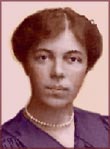 One
of the last Grand Duchesses to survive the Revolution
was Anastasia's dear aunt Olga, who escaped from Russia during
the revolution and moved to Denmark and then to Canada. One
of the last Grand Duchesses to survive the Revolution
was Anastasia's dear aunt Olga, who escaped from Russia during
the revolution and moved to Denmark and then to Canada.
She lived out her final years above a barbershop painting
and raising her children. She married Colonel Nickolai Koulikovsky
and had two sons.
Neighbors were shocked when Queen Elizabeth II of England
extended an invitation to the kindly elderly woman to join her
for tea during a tour in Canada in 1959.
To the end she remained loyal to the memory of her brother
and the rest of her family.
She was buried at the York Cemetery
in Toronto, Canada in 1960. |
|


 The
mystery surrounding Anastasia's fate after the Russian
The
mystery surrounding Anastasia's fate after the Russian  There
were four girls, born right after one another in succession to the
Imperial couple of
There
were four girls, born right after one another in succession to the
Imperial couple of  Beneath
the surface of her royal life full of wealth, prominence, and opulence,
you could find a typical preadolescent who misses her
Beneath
the surface of her royal life full of wealth, prominence, and opulence,
you could find a typical preadolescent who misses her 
 The
two eldest, Olga and Tatiana shared one bedroom and the two youngest,
Maria and Anastasia shared the one next door. They lived in one
side of the
The
two eldest, Olga and Tatiana shared one bedroom and the two youngest,
Maria and Anastasia shared the one next door. They lived in one
side of the 
 At
the time of the abdication Anastasia and her siblings were
suffering from measles. While they were confined to their
beds the palace was taken over by soldiers. The imperial family
were now prisoners. When the children recovered they went
outside each day with their parents to walk in the park, where
they were harassed and jeered.
At
the time of the abdication Anastasia and her siblings were
suffering from measles. While they were confined to their
beds the palace was taken over by soldiers. The imperial family
were now prisoners. When the children recovered they went
outside each day with their parents to walk in the park, where
they were harassed and jeered.
 Their
last day was July 16, 1918. Late that night, the family was
awakened and told to get dressed.
Their
last day was July 16, 1918. Late that night, the family was
awakened and told to get dressed.  One
of the last Grand Duchesses to survive the
One
of the last Grand Duchesses to survive the